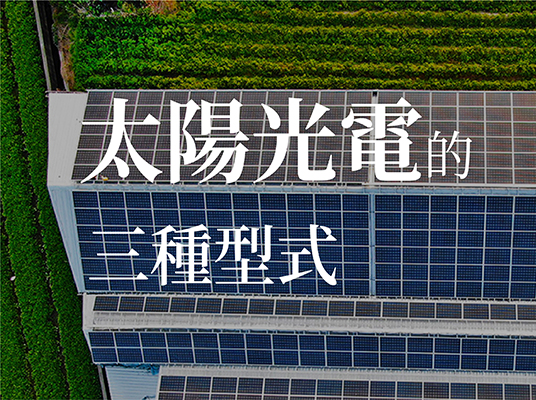Three types of solar photovoltaics
2023.08.17
Solar energy is a very good renewable energy. Do you know what types of solar photovoltaic there are? Let us introduce you to the various types of solar photovoltaics and their advantages and disadvantages, and explain why Innolux Energy chooses to focus on rooftop solar photovoltaics.
What are the five major benefits of promoting solar energy?
● Reduce carbon emissions.
● Reduce air pollution.
● Relieve peak power stress.
● Improve energy self-sufficiency and promote domestic economic growth.
● Decommission nuclear energy and achieve the goal of a nuclear-free world by 2025.
Why did Innolux Energy choose to focus on rooftop solar photovoltaics?
Rooftop solar photovoltaics are mainly installed on top of existing buildings, effectively utilizing the existing developed space. We uphold the original intention of being friendly to the environment and hope to provide renewable energy while solving the problems encountered by commercial factories, agricultural livestock houses, and self-use residences, such as improving the workplace to make the working environment cooler, and providing more space on the roof of the house... so that partners who love the earth can have a better use environment.
Rooftop solar energyPhotovoltaic is divided into trellis type and flat type.
|In addition to rooftop solar photovoltaics, there are also the following two types.
Ground-mounted solar photovoltaic
Large power plants can often be seen in countries such as Germany, France, and Australia because of their vast land. Compared to Taiwan, which has a large population, small land, and rich ecology, more careful evaluation is required when developing ground-mounted solar photovoltaics in order to meet the expectations of solar photovoltaics being environmentally friendly. The hasty opening of agricultural and electricity symbiosis in the early years caused chaos in the form of fake farming and real electricity planting, and was quickly stopped due to social controversy.
Currently, the government only allows ground-based photovoltaic installations in landfills, reservoir ponds, salt industry land, areas with severe ground subsidence, polluted areas, areas prone to flooding, and other areas that are not conducive to farming.
Ground-mounted solar photovoltaics are mainly divided into fixed and sun-chasing types.

Further reading
Water surface solar photovoltaic
Water surface solar photovoltaic equipment is installed in reservoirs, detention ponds, ponds, fish ponds, and nets The Water Conservancy Department of the Ministry of Economic Affairs and the Council of Agriculture are responsible for the planning and promotion of water fields and embankments respectively.
▲The country's largest "water-based floating solar power generation system" generates 8 million kilowatt-hours in Tainan annually.
The supporting structure of water-based solar photovoltaics is divided into two types: floating and fixed. In fact, the installation form will be selected based on the evaluation of various phenomena such as the terrain, changes and movement of water in nature.
Characteristics of surface solar photovoltaics
● Reduce the occupation of land resources
● Reduce water evaporation
● Reduce Water quality optimization
● Water helps cool solar photovoltaic systems
Further reading
● Water Resources Agency: Q&A on water-based solar photovoltaics
Warmth transmission, sustainable value
Innolux Energy adheres to the original intention of creating a friendly life and uses the existing space to think about how to develop renewable energy while using solar modules to improve the existing environment, do our part for the earth, and let this warmth be passed on.

